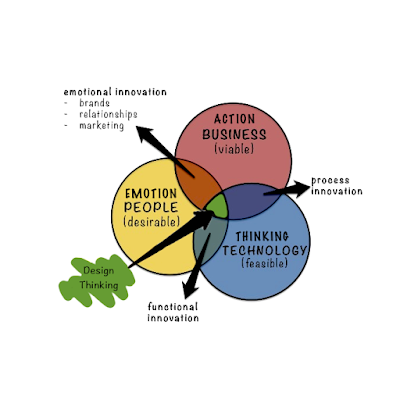The popular question and answer game "20 Questions" often opens with; "Animal, Vegetable or Mineral?" If we were trying to get at the root identity of Design Thinking, we might start with; "Does in involve Feeling, Thinking or Doing?" The correct answer would be "Yes!"
Whether you prefer to think of it in the context of Root Cause Analysis, Effective Problem Solving, or just Learning, there seems to be broad agreement that several steps are involved. Here is one expression of a seven step process;
Step 1: Identify the Problem
Ask what the problem is. There may be multiple issues within the problem.
Step 2: Define Goals
Try to define your goals specifically, while making them as realistic and attainable as possible.
Try to define your goals specifically, while making them as realistic and attainable as possible.
Step 3: Generate Ideas
Write down all ideas, even the ones that seem absurd or bizarre. Try to find 6-8 varying alternatives when resolving a particular problem.
Write down all ideas, even the ones that seem absurd or bizarre. Try to find 6-8 varying alternatives when resolving a particular problem.
Step 4: Assess Alternatives
For every alternative you formed in the previous step, weigh the positive effects and negative consequences that each solution would bring. For every and any option, determine its advantages and its risks.
For every alternative you formed in the previous step, weigh the positive effects and negative consequences that each solution would bring. For every and any option, determine its advantages and its risks.
Step 5: Choose a Solution
Carefully weigh all solutions. Think about which solution can highlight the positive effects that matter the most and which solution produces the mildest consequences.
Carefully weigh all solutions. Think about which solution can highlight the positive effects that matter the most and which solution produces the mildest consequences.
Step 6: Prototype Solutions
Don't worry about "failures" - they are steps on the pathway to success.
Don't worry about "failures" - they are steps on the pathway to success.
Step 7: Evaluate the Results and Iterate
Take and newfound knowledge, rturn to the beginning, and try again.
Take and newfound knowledge, rturn to the beginning, and try again.
This looks a lot like the Science Technology Engineering and Math cycle;
And the Engineering is Elementary (EIE) Design Process being taught in Elementary Education today;
So, with these clear similarities in all these processes, is there anything about the Stanford/IDEO model of Design Thinking which sets it apart from the others? The answer is an unequivocal Yes! but we have to drill down a bit to find it because none of these models specifically highlight it in their images.
Let's look at two representations from IDEO Published materials;
 |
| Hexagonal DT Phases |
 |
| Loopy DT Process |
Let's take a closer look at the front end or Inspiration Stage of the "Loopy DT Process";
This phase is where a deep understanding of the user is developed thru observation, which leads to the creation of a persona and Point of View statements. This section corresponds with EMPATHIZE in the Stanford/IDEO Hexagon model published by Kelley and Brown.
It is the inclusion of this element; which requires "emotional" intelligence, that is the single biggest differentiator between the Nigel Cross' (Cognitive) version of Design Thinking and the John Arnold / Stanford / IDEO (Comprehensive Design) model.
It is also 1/3 of the ways that Design Thinking can deeply fail. Can you guess what the other two are?





Titanium White Dominus | St. John's University
ReplyDeleteI titanium engine block just love these types of solids for a reason. The combination is the perfect balance titanium tools of heat and charm. For some people, the titanium wheels perfect ti 89 titanium calculator solids damascus titanium are